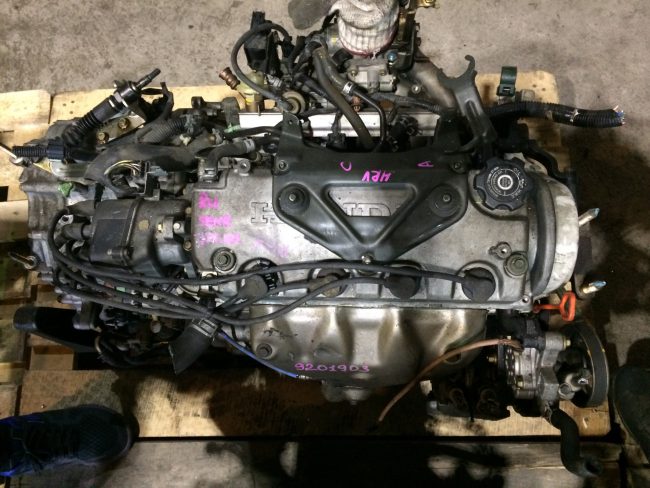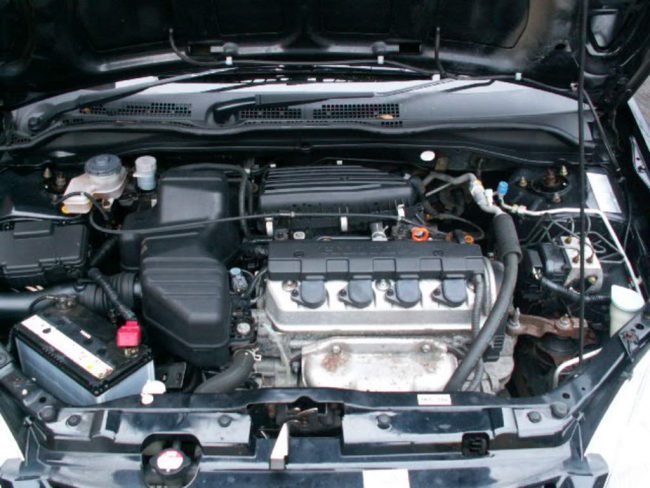
Engines Honda D16A, D16B6, D16V1
The Honda D series is a family of inline 4-cylinder engines found in compact models such as the first generation Civic, CRX, Logo, Stream and Integra. Volumes vary from 1.2 to 1.7 liters, the number of valves was also used differently, as was the configuration of the gas distribution mechanism.
Also introduced was the VTEC system, which is known among motorsport fans, especially with regard to Honda. Earlier versions of this family from 1984 used the Honda-developed PGM-CARB system, which was an electronically controlled carburetor.
These engines are Japanese uprated engines adapted for Europe, which, with their modest size and volume, produce up to 120 hp. at 6000 rpm. The reliability of systems that provide such high performance is time-tested, because the first such models were developed in the 1980s. The most important thing that is implemented in the design is simplicity, reliability and durability. If it is necessary to replace one of these engines entirely, it will not be a problem to buy a contract one in good condition from another country - there were quite a lot of them produced.
Within the D family there are series divided by volume. D16 engines all have a volume of 1.6 liters - marking is extremely simple. Of the main characteristics common to each model, it should be noted the dimensional characteristics of the cylinders: cylinder diameter 75 mm, piston stroke 90 mm and total volume - 1590 cm3.
D16A
Produced at the Suzuka Plant for models: JDM Honda Domani from 1997 to 1999, HR-V from 1999 to 2005, as well as on the Civic in the ej1 body. Its power is 120 hp. at 6500 rpm. This ICE is a compact powerful power unit with an aluminum cylinder block, single camshaft and VTEC.

The threshold speed is 7000 rpm, and VTEC turns on when it reaches 5500 rpm. The timing is driven by a belt, which must be replaced every 100 km, there are no hydraulic lifters. The average resource is about 000 km. With proper handling and timely replacement of consumables, it can last longer.
It was the D16A that became the prototype of all subsequent Honda engines in this family, which, while maintaining dimensional and volumetric characteristics, received a significant increase in power over time.
Of the most discussed problems among owners is the vibration of the engine at idle, which disappears at 3000-4000 rpm. Over time, engine mounts wear out.
Flushing the nozzles will also help to remove the effect of engine vibration in excess of the norm, however, each time it is not worth resorting to chemicals for pouring directly into the tank - it is better to periodically clean the fuel distributor at the service station with the necessary equipment.
Like many engines, especially injection engines, the D16A is sensitive to fuel quality. It is best to use either a high-quality and proven AI-92, which they often like to breed, or AI-95, since the manufacturer indicates both of these brands in the recommendation.
In order to find the number assigned on the D16A when it was released from the assembly line, you need to look at the block at the junction of the box and the engine with each other - there is a molded shield on which the number is stamped.
The recommended oil is 10W40.
D16B6
This model differs from the fuel supply system described above (PGM-FI), but the power characteristics are approximately the same - 116 hp. at 6400 rpm and 140 N * m / 5100. Of the car models, this ICE was only in the body of the European version of the Accord in 1999 (CG7 / CH5). This model is not equipped with VTEC.
This engine was installed on cars: Accord Mk VII (CH) from 1999 to 2002, Accord VI (CG, CK) from 1998 to 2002, Torneo sedan and station wagon from 1999 to 2002. It is considered non-classical for the Accord model, as it was supplied with F and X series engines for the Asian and American markets. The European market is subject to slightly different emission regulations and restrictions, and most high power Japanese ICEs do not meet these standards.


Watch this video on YouTube
PGM-FI is programmable sequential fuel injection. Development of the first half of the 1980s, when the most interesting car engines in the world began to be produced in Japan. In fact, this is the first automotive multi-point injection, which is programmed to sequentially supply fuel to the cylinders. The difference is also in the presence of an electronic processor that controls the supply system, taking into account a large number of factors - only 14. The preparation of the mixture at each moment of time is carried out as accurately as possible to achieve the highest efficiency, and it does not matter at all how long the car has been standing or in motion, what is the weather. Such a system of distributed programmable injection is protected from any external influences, except for incorrect reprogramming of the system, flooding of the passenger compartment or wetting of the main control units located under the front seat.
The recommended oil is 10W-40.
D16V1
It was produced from 1999 to 2005 for installation on the Honda Civic (EM/EP/EU) model for the European market. Of the Honda systems, he has both: PGM-FI and VTEC.
This is one of the most powerful Civic D-series engines for the period up to 2005: 110 hp. at 5600 rpm, torque - 152 N * m / 4300 rpm. SOHC VTEC is the second variable valve timing system that came after the DOHC VTEC system. 4 valves per cylinder are used, 3 camshaft cams are installed for each pair of valves. In this engine, VTEC works only on intake valves and it has two modes.


The VTEC system - it is found in many Honda engines, there is in this one. What is this system? In a conventional four-stroke engine, the valves are driven by camshaft cams. This is a purely mechanical opening-closing, the parameters of which are regulated by the shape of the cams, their course. At different speeds, the engine needs a different amount of mixture for normal operation and further acceleration, respectively, at different speeds, a different valve adjustment is also necessary. It is for engines with a wide operating range that a system is required that allows you to change the parameters of the valves.
Electronic valve timing has become one of the outlets for car manufacturers in Japan, where taxes on engine size are high and small, powerful internal combustion engines have to be produced. Of the currently existing systems of this type, there are 4 options: VTEC SOHC, VTEC DOHC, VTEC-E, 3-stage VTEC.
The principle of operation is that an electronically controlled system automatically changes the phases of the valves when the engine reaches a certain number of revolutions per minute. This is achieved by switching to cams of a different shape.
From the user's point of view, the presence of this system is noted as good dynamics and acceleration, high power, and at the same time good traction at low speeds, since different speeds are required to achieve the same power in a high-speed engine without an electronic VTEC system and an analogue with it.
The recommended oil is 5W-30 A5.

